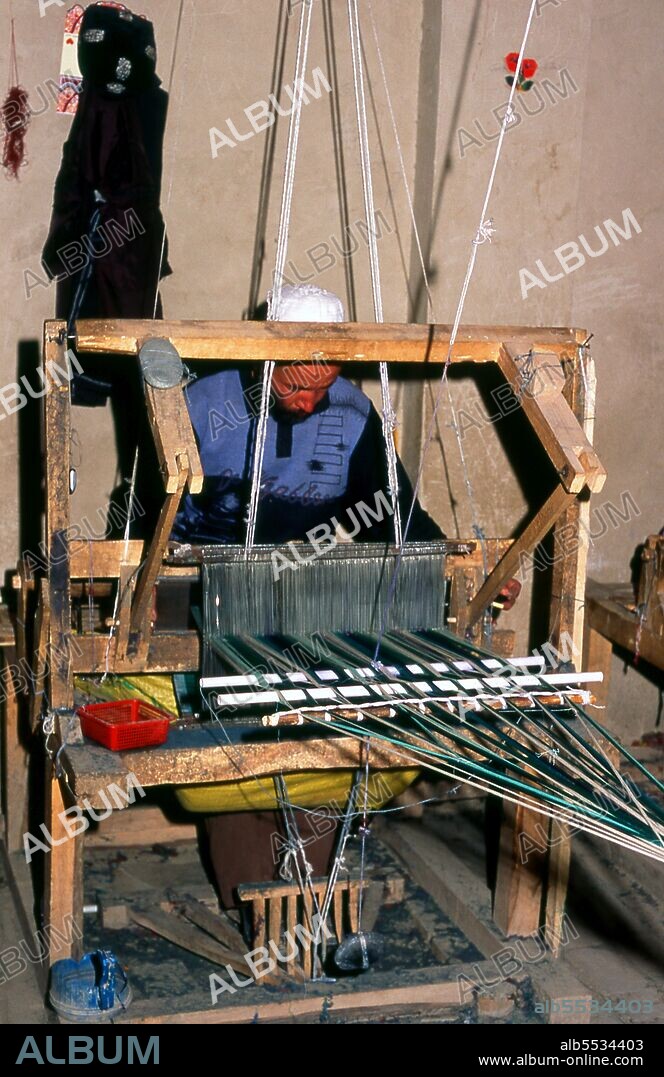alb5534403
China: A Uighur man silk weaving, Atlas Silk Workshop (Atlas Karakhana) in Jiya Village, about 13km northeast of Khotan, Xinjiang Province.

|
Add to another lightbox |
|
Add to another lightbox |



Buy this image.
Select the use:

Title:
China: A Uighur man silk weaving, Atlas Silk Workshop (Atlas Karakhana) in Jiya Village, about 13km northeast of Khotan, Xinjiang Province.
Caption:
During the first half of the 1st century CE, silk worm technology is thought to have reached the Han-Chinese dominated oasis of Khotan in the Tarim Basin – an oasis that is still a centre of silk production today. A Chinese princess given in marriage to a Khotan prince is said to have carried the eggs of silkworms to her new husband concealed in her hair. It is thought that silkworms and knowledge of sericulture travelled from Khotan south to India and west to Sassanid Persia during the 4th century BC AD, while records also recount a Japanese expedition to China in the same century carrying four silk-weaving girls, together with silkworm eggs, back to Japan. Khotan traces its history back at least as far as the 3rd century BCE, when the eldest son of the Indian emperor Asoka is said to have settled here. It was of great importance on the Silk Road, and is claimed to have been the first place outside China to have cultivated silk. It sits astride the Karakash or ‘Black Jade’ and Yurungkash or ‘White Jade’ Rivers, which here conjoin to form the Khotan Darya, and has been famous for its jade for well over two millennia. In times past trade routes crossed the desert to the north all the way to Kuqa, and as recently as 2007 this link has been re-established for the first time in centuries with the opening of a second Desert Highway leading to Aksu, distant some 424km to the north. In 1006 Khotan was conquered by Uighur Muslims from Kashgar, and since that time the city remains a very Uighur place.
Credit:
Album / David Henley/Pictures from History/Universal Images Group
Releases:
Model: No - Property: No
Rights questions?
Rights questions?
Image size:
3309 x 5100 px | 48.3 MB
Print size:
28.0 x 43.2 cm | 11.0 x 17.0 in (300 dpi)
Keywords:
ASIA IMAGES • ASIA PICTURES • ASIA • ASIAN IMAGE • ASIAN IMAGES • ASIAN PICTURES • ASIAN • CHINA • CHINE • CHINESE • CLOTHES • CLOTHING • CLOTHINGS • COSTUME • DAVID HENLEY • DRESS • DRESSED • FABRIC • GARMENT • HABIT • HETIAN • HISTORIA UNIVERSAL • HISTORIA • HISTORICAL IMAGES • HISTORICAL PICTURES • HISTORICAL • HISTORY IMAGES • HISTORY PICTURES • HISTORY • HISTORY. • HOTAN • INDUMENTARIA • INDUSTRY • KHOTAN • PORCELAIN • ROBE • SILK ROAD • SILK ROUTE • SILK • SINKIANG • SUIT • TEXTILE • TEXTILES: SILK • TRADE • UIGHUR • UYGHUR • WEAVER • WEAVERS • WEAVING • XINJIANG
 Pinterest
Pinterest Twitter
Twitter Facebook
Facebook Copy link
Copy link Email
Email
